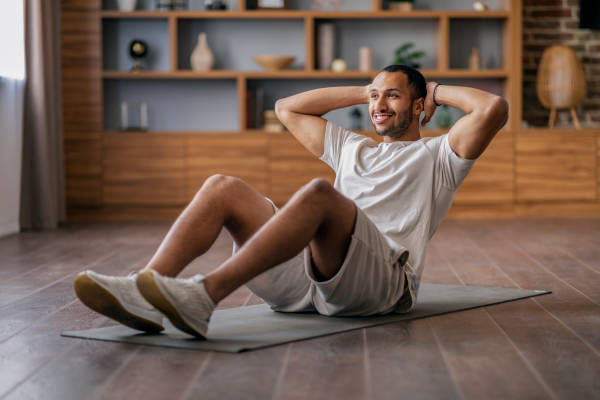Discover the correct techniques and common mistakes to avoid when doing sit-ups Learn how to maximize the benefits while ensuring your safety in our comprehensive guide to proper sit-up form
Many people include sit-ups in their workout routines to strengthen their core and achieve better abdominal definition. While sit-ups can be beneficial, they must be performed correctly to maximize their effectiveness and minimize the risk of injury. In this article, we will explore the proper way to do sit-ups, including techniques, tips, and common mistakes to avoid. Whether you're a beginner or looking to refine your form, understanding the right way to do sit-ups can help you achieve your fitness goals while safeguarding your well-being.

Understanding Sit-Ups
Sit-ups are a classic abdominal exercise that target the core muscles. They involve lying on your back, bending your knees, and lifting your upper body off the ground. Understanding how to do sit-ups correctly and the muscles they engage is essential for getting the most out of this exercise.
What are sit-ups?
Sit-ups are a form of calisthenic exercise designed to strengthen the abdominal muscles. They require you to lie on your back with your knees bent and your feet flat on the floor. Your hands are often placed behind or beside your head. The primary movement involves lifting your upper body from the ground towards your thighs. This action engages the rectus abdominis, commonly referred to as the "abs."
Muscles targeted during sit-ups
The main muscle group targeted during sit-ups is the rectus abdominis, which runs vertically along the front of your abdomen. Additionally, sit-ups engage the hip flexors and the obliques, which are located on the sides of your abdominal area. Together, these muscles provide stability, assist in flexing the spine, and support your core.
Importance of proper form
Performing sit-ups with proper form is crucial to prevent strain and injury. Correct form ensures that the targeted muscles are effectively engaged, leading to better results and reduced risk of back or neck discomfort. In the next sections, we'll explore the right way to do sit-ups and the benefits of maintaining proper form.
The Right Way to Do Sit-Ups
Performing sit-ups correctly is essential to maximize their benefits and avoid strain or injury. Follow these steps for proper sit-up form:
- Starting Position: Lie on your back on an exercise mat or a comfortable surface. Bend your knees and place your feet flat on the floor. Keep your feet hip-width apart. You can either cross your arms over your chest or place your hands behind your head, just make sure not to pull on your neck.
- Engage Your Core: Before you begin, engage your core muscles by drawing your navel toward your spine. This provides stability to your lower back during the movement.
- Lift Your Upper Body: Inhale and slowly lift your upper body off the ground. Keep your back straight and use your core muscles to lift, not your neck or shoulders. Exhale as you reach the top of the movement.
- Full Range of Motion: Lower your upper body back down, but do not let your shoulder blades touch the ground. Maintain tension in your core. Aim for a full range of motion without straining your neck or back.
- Repeat: Complete the desired number of repetitions while focusing on controlled movements and proper breathing.
Keep in mind that sit-ups should be performed with control, and the goal is quality over quantity. Rushing through them with improper form can lead to injury and limit their effectiveness. If you're new to sit-ups or have any concerns, it's a good idea to consult a fitness professional to ensure you're performing them correctly.
Benefits of Correct Sit-Up Technique
The benefits of performing sit-ups with the correct technique go beyond just toning your abdominal muscles. Here are some advantages of doing sit-ups properly:
- Core Strength: Properly executed sit-ups are one of the most effective exercises for strengthening your core muscles, including the rectus abdominis and the obliques. A strong core provides stability to your entire body, reducing the risk of back pain and improving posture.
- Toning Abdominal Muscles: Correct sit-ups target your abdominal muscles, helping to tone and define your midsection. Over time, this can lead to a flatter and more sculpted stomach.
- Improved Posture: Strong core muscles support your spine and help you maintain good posture. This can reduce the risk of slouching and back strain, especially if you sit for long periods during the day.
- Enhanced Athletic Performance: A strong core is essential for many sports and physical activities. Improved core strength can enhance your performance in activities such as running, swimming, and weightlifting.
- Back Pain Prevention: By strengthening your core, sit-ups can help prevent lower back pain by providing better support to your spine. However, it's crucial to perform them correctly to avoid straining your back.
- Overall Fitness: Incorporating sit-ups into your workout routine can contribute to overall fitness and a balanced exercise regimen. They complement other exercises that target different muscle groups.
Keep in mind that while sit-ups can offer these benefits when performed correctly, it's essential to maintain proper form to avoid injury. If you're new to sit-ups or have specific health concerns, consult a fitness professional or healthcare provider for guidance.
Sit-Ups Variations
Sit-ups can be modified in various ways to add diversity to your core workouts and target different muscle groups. Here are some sit-up variations you can try:
- Basic Sit-Up: Lie on your back with knees bent, feet flat on the floor. Cross your arms over your chest or place your hands behind your head. Lift your upper body off the ground by contracting your abdominal muscles.
- Crunch: Similar to a basic sit-up, but you only lift your upper back and shoulders off the ground, keeping your lower back on the floor. This variation reduces strain on your lower back.
- Leg Raises: Lie on your back with your legs extended. Lift your legs off the ground while keeping them straight. You can also raise your legs to a 90-degree angle or higher.
- Russian Twist: Sit on the floor with your knees bent and feet flat. Lean back slightly and lift your feet off the ground. Twist your torso to the left and right while touching the floor on each side with your hands.
- Bicycle Crunch: Lie on your back, lift your shoulders off the ground, and bring your right elbow toward your left knee while extending your right leg. Alternate to the other side, mimicking a pedaling motion.
- Reverse Crunch: Lie on your back with your knees bent and feet lifted off the ground. Bring your knees toward your chest while lifting your hips off the ground.
These variations can help target specific abdominal muscles and provide a more comprehensive core workout. Remember to maintain proper form and avoid straining your neck or back during these exercises.
Common Sit-Up Questions
If you're looking to perform sit-ups correctly and effectively, you might have some questions. Here are answers to some common inquiries:
- Q1: How many sit-ups should I do daily?
A1: The number of sit-ups you should do daily depends on your fitness level and goals. It's more effective to focus on quality over quantity. Start with a number that challenges you but can be performed with proper form. Gradually increase the repetitions as you build strength.
- Q2: Can sit-ups help me get a six-pack?
A2: Sit-ups can be part of a core-strengthening routine, but visible abs also depend on a balanced diet and overall body fat percentage. To get a six-pack, combine sit-ups with a healthy diet and other exercises that target your core.
- Q3: Are sit-ups harmful to the back and neck?
A3: Sit-ups can strain your back and neck if done incorrectly. It's essential to maintain proper form by engaging your core muscles and not pulling on your neck during the exercise. If you have pre-existing back or neck issues, consult a healthcare professional before doing sit-ups.
- Q4: When is the best time to do sit-ups?
A4: There is no specific "best" time for sit-ups. You can perform them when it's most convenient and suits your routine. Some people prefer morning workouts, while others may choose evenings. Focus on consistency and finding a time that works for you.
- Q5: What's the difference between sit-ups and crunches?
A5: Sit-ups and crunches target the same muscle group (abdominals), but they differ in range of motion. Sit-ups involve lifting your entire upper body off the ground, while crunches lift only the upper back and shoulders. Depending on your preferences and needs, you can choose either exercise.
These answers provide guidance to some of the common questions individuals have regarding sit-ups. Remember to perform sit-ups with proper form and consult a fitness professional if you have specific concerns or goals.
FAQs About Sit-Ups
- Q1: Are sit-ups effective for toning the abdominal muscles?
A1: Yes, sit-ups are effective for strengthening and toning the abdominal muscles. They primarily target the rectus abdominis and can help you achieve a more defined core when performed correctly.
- Q2: How can I avoid straining my neck while doing sit-ups?
A2: To prevent neck strain, place your hands gently behind your head or cross your arms over your chest. Avoid pulling your head or neck during the exercise. Keep your neck and spine aligned throughout the movement.
- Q3: Can sit-ups help reduce belly fat?
A3: Sit-ups primarily strengthen the abdominal muscles but may not directly reduce belly fat. To reduce fat in that area, combine sit-ups with a calorie-controlled diet and overall fat-burning exercises such as cardio.
- Q4: How often should I do sit-ups to see results?
A4: The frequency of sit-ups depends on your fitness goals. To maintain core strength, a few times a week might be sufficient. If you aim for visible results, gradually increase the number of repetitions and perform them regularly, but always prioritize proper form.
- Q5: Are sit-ups the best exercise for core strength?
A5: Sit-ups are one of many exercises that can strengthen your core. Other exercises like planks, leg raises, and twists can also be effective. The "best" exercise depends on your preferences and individual needs, so it's essential to diversify your core workouts.










